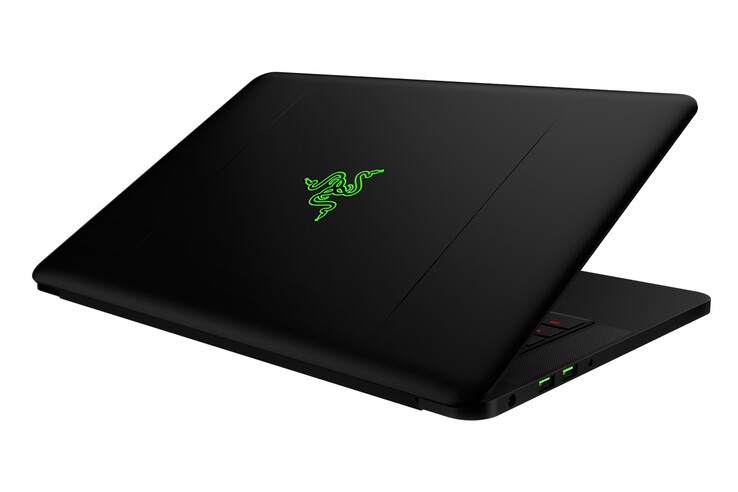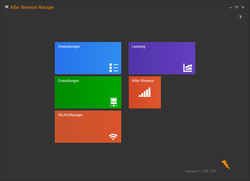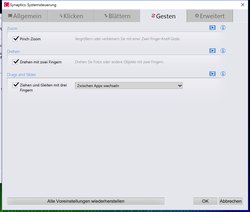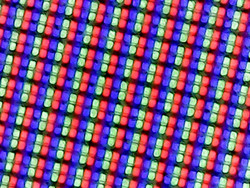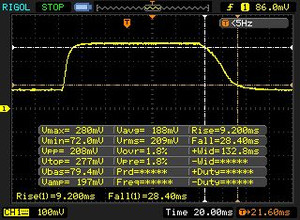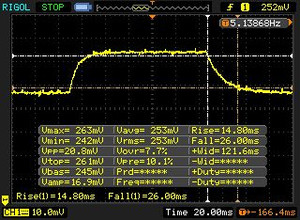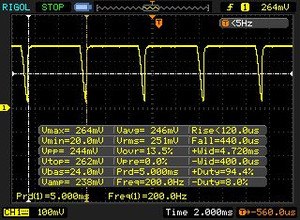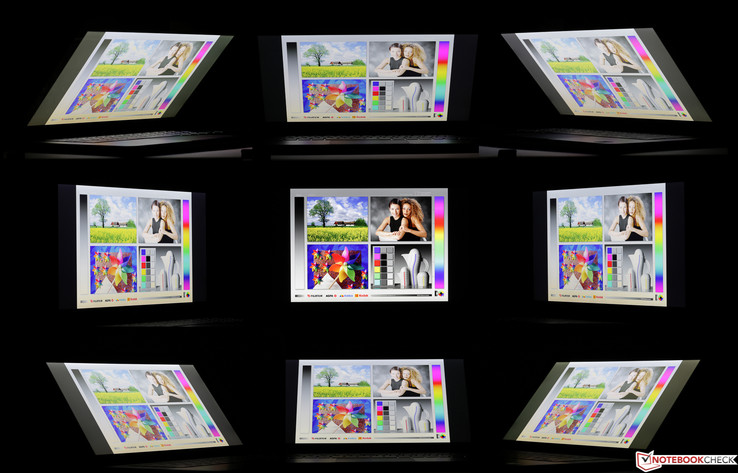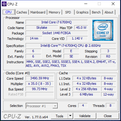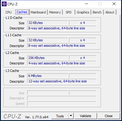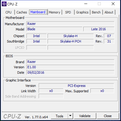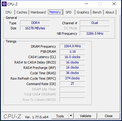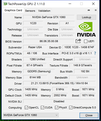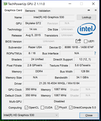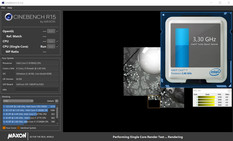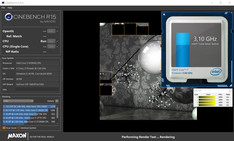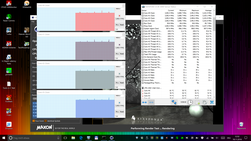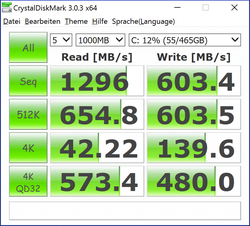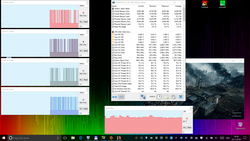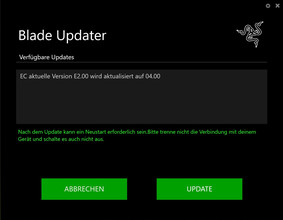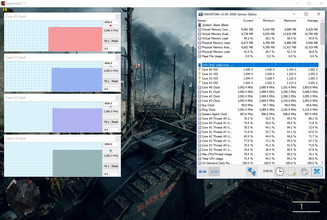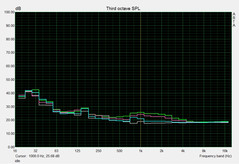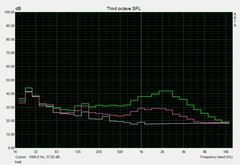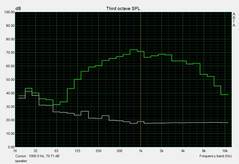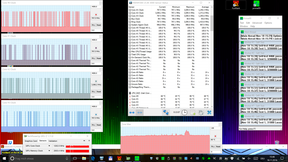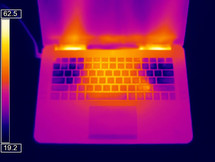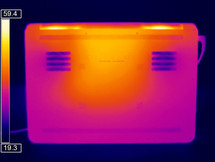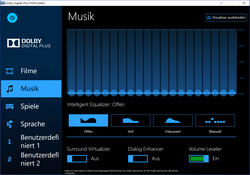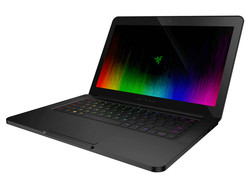Razer Blade (2016) Notebook Review

For the original German review, see here.
Few manufacturers are interested in building a compact, 14-inch gaming laptop. In the past few years, only MSI, Alienware, Clevo, Gigabyte and Razer decided to construct such notebooks. Although this category has a low population, we have encountered variants from it before: in 2013, we tested the predecessor of the current Razer Blade (2016). The case may not have changed much, but the display and the hardware have definitely been upgraded.
Razer decided to launch an early 2016 refresh of its compact gaming line. This refresh included a Skylake CPU, Thunderbolt 3 (via USB Type-C), an SSD (PCIe interface) and the Nvidia GeForce GTX 970M. With the new Blade, Razer has decided to take another step forward and has grabbed the Nvidia GeForce GTX 1060 from the Pascal generation.
Our test model has an English keyboard layout. However, Blades bought in Germany should arrive with a German layout. The manufacturer offers six different configurations. This variety is made possible by two different screens and three SSDs with differing capacities. Our test model uses the 3200x1800 pixels IGZO touchscreen. While the alternative (an FHD panel) may have a lower resolution, it seems to be the more sensible choice when one considers the compact size and graphics card of this notebook. We will delve into this point further on.
When it comes to talk about storage, the user has a lot to choose from: SSDs with 256 GB, 512 GB or 1 TB are available. For the cheapest Blade (a 256 GB SSD and an FHD panel), the buyer will shell out around 2,000 Euros (~$2152). This price tag will increase to around 3,000 Euros (~$3229) if the buyer decides to invest in a QHD+ screen and a 1 TB SSD. For configurations with the higher-resolution screen, the buyer must invest an extra 300 to 400 Euros (~$322 to ~$430, relative to the FHD configurations). At the end of the day, the six configurations have a lot in common: they share the same case, connectivity, CPU (Intel Core i7-6700HQ), 16 GB of RAM, GTX 1060 (6 GB of graphics memory) and other features.
There are few similarly portable gaming laptops. As such, it was easy to compile a list for comparison. We selected two 14-inch laptops and a larger gaming notebook (using the GeForce GTX 1070). All the models are equipped with an i7-6700HQ:
- Schenker XMG P406 (GTX 970M)
- MSI GS43VR 6RE-006US (GTX 1060)
- Asus Strix GL502VS-FY032T (15.6-inch, GTX 1070)
Case
Razer is offering an aluminum unibody. At 17.9 mm, this gaming laptop is extraordinarily slim. True unibody cases are milled out of a single block of metal and do not have a maintenance hatch on the bottom (unlike our model). This does not affect the stability though. Our test model can comfortably withstand pressure, and we could not deform the case at all, despite using all our force. This is without a doubt the sturdiest and most sophisticated case the tester came across. The stiff display is also quite resistant as it barely warps under pressure. The excellent impression is rounded off with the almost perfectly adjusted hinge, which is strong enough to prevent wobbling, but it still allows the user to open the lid with one hand.
The design is a matter of taste, but the reviewer felt comfortable with the matte-black surfaces, which unfortunately attract a lot of fingerprints. The case features rounded corners and slightly beveled edges. To prevent these edges from pressing uncomfortably into the hands, Razer has angled the edge (near the touchpad) away from the user. Overall, the design is simple yet appealing. It sports a clear, masculine tone. The laptop already looks great, but we certainly appreciate the extras: The speaker grilles on the right and left sides of the keyboard and the tribal Razer logo on the back (can be lit in different colors) are fine additions.
We took the 15-inch model out of the size comparison. Of the three remaining models, the Razer Blade is clearly the most compact system: It has the smallest dimensions, with the exception of the width, which is identical to that of the MSI model. The Schenker has the largest footprint and is the thickest model at 25 mm. It is also the heaviest, as it weighs 2.2 kg.
Connectivity
Many passionate users prefer Ethernet cables to WLAN modules when playing games (due to the higher reliability and lower ping). The Razer Blade, however, does not have an Ethernet port, and it does not come with a card reader, either. Otherwise, everything a modern user might want is included in the laptop. 2x USB 3.0 and Thunderbolt 3 via USB Type-C are provided. The HDMI 2.0 output can handle 4K videos on an external monitor at 60 Hz.
Traditional headsets will not find the appropriate ports on this laptop, as the headphone and microphone jacks have been reduced to a combo jack. Thanks to sufficient space, Razer is able to distribute all ports towards the back of the laptop. This will reduce the inconvenience of mixing up cables when using an external mouse.
Communication
Without an Ethernet port, at least the WLAN performance has to be pretty good. Razer has picked the Killer Wireless-AC 1535 module, as it is designed for gamers and sports various features and options for customization (see screenshot). We took a close look at it here. It can support the traditional standards of the overcrowded 2.4 GHz frequency and the ac standard for the 5 GHz frequency (used relatively less). Bluetooth 4.1 is on-board.
Thanks to the MIMO 2x2 configuration, the laptop can theoretically reach up to 866 MB/s. In ideal conditions (one meter from the router), the laptop manages 646 Mbit/s (receiving) and 591 Mbit/s (sending).
| Networking | |
| iperf3 transmit AX12 | |
| Razer Blade (2016) | |
| iperf3 receive AX12 | |
| Razer Blade (2016) | |
Accessories
Aside from the obligatory 165-Watt power adapter, the box includes a cleaning cloth and the standard warranty and information leaflets. It seems the manufacturer will not be offering any optional accessories specifically designed for the Razer Blade.
Maintenance
The laptop does not have a maintenance flap and the battery is not removable from the outside. However, it is possible to gain access to the hardware on the inside of the laptop (see photo gallery below "Case") by removing the 10 Torx screws keeping the bottom plate in place.
Warranty
As Razer will sell its new gaming laptop in Germany as well, the laptop will not only have a one-year manufacturer warranty, but it will also have a full two years of guarantee (in accordance with the law).
Input Devices
Keyboard
As the U.S. keyboard is as wide as a desktop keyboard, the keys are decently sized with a comfortable spacing. The flat keys also have a slight anti-slippery coating. The skinny key lettering is an inconvenience. We would have liked bigger or thicker characters, as this would have improved the visibility, especially for keys with secondary functions, where the lettering is way too small and not illuminated. Except for the fact that directional keys (some half-sized) are integrated into the lower right side of the keyboard, the layout does offer more surprises. Some special characters like punctuation or mathematical operators are not in their usual spots. This means there will be a certain training period.
The user will need to press hard to bend the keyboard near the middle. This means that during normal typing, the laptop keyboard will offer a reliable base. The keys have a shallow travel with a well-perceptible, but not very firm pressure point and only a slight impact cushioning. The tester liked the typing experience, but it might cause the fingers to tire out faster. Overall, the feedback while typing could still be improved. The noise development during typing allows limited use in noise-sensitive environments.
Let's take a look at the lighting of the keyboard. To our surprise, the backlight can only be configured after the user has set up an account with Razer. This allows the manufacturer to save the user settings in the Cloud, but we did not appreciate this obligation to register. After all, the buyer is spending a lot of money to buy a gaming laptop and, in our opinion, the manufacturer should not be dictating when they can use the functions of the device they have purchased.
The Chrome keyboard backlight is bright and offers a lot of customization options: Each key can individually be set to one of 17 million colors (according to Razer). Furthermore, the user can set up keyboard zones with different colors. Chroma can also adjust the lighting intensity to steadily rise and fall with the "Breathing" option or it can imitate embers with "Fire" mode. With the "Reactive" mode active, the keyboard will allow keys to light up when pressed and then fade a little. The cherry on top of it all: compatible games, like Rise of the Tomb Raider, will allow the keyboard to provide special effects during the game. If Chroma support is activated in the game settings, the system will highlight relevant keys (to set them apart from others) and display a couple of nice lighting effects in certain in-game scenarios.
Touchpad
Many gamers will be grateful that Razer has decided to stick with a traditional touchpad with separate mouse keys. This device has a large surface, but thanks to configured zones on the outer ends, it will not react to accidental touches. It appears that these zones are reserved for scrolling. At the same time, if you move your finger from the middle of the touchpad to the outer ends, the device will recognize the movement to the furthest reaches of the pad. The slightly rough, black surface still offers good gliding capabilities with slightly moist fingers, but very sweaty fingers will stick a bit. Precision and response of the touchpad are great, as it is capable of following the fastest motions. Drag & Drop operations work reliably with a double tap.
Sadly, the separate mouse keys are not as well-built. They have a shallow travel and feel rickety. Although the resistance is low, they offer a clear and slightly audible pressure point. This means the feedback is decent but not great. The Synaptics menu will allow users to configure the touchpad with gestures for up to three fingers. Alternatively, the user can configure the pad with the Windows 10 settings.
Touchscreen
The 10-point touchscreen is fast and reacts reliably to inputs (even in the furthest corners). We did not encounter any issues during our test. In comparison to the previously tested Lenovo Yoga 510, the touchscreen is kind to moist fingers and willing to recognize their inputs without complaints. We believe this may be due to a superior coating or calibration.
Display
Razer has chosen an unusual QHD+ IGZO display from Sharp (3800x1800 pixels, 262 PPI). We prefer the cheaper and matte Full HD screen. The pixel density of 262 PPI is not distinguishable by the naked eye. A GTX 1060 is the right choice for an FHD panel. This GPU is overtaxed when running games at higher resolutions. The glossy surface is a result of the touchscreen, which is not common and not really that practical on a gaming notebook. Finally, we believe FHD is also the best choice as Windows has still not eliminated its scaling issues. This will especially affect older software.
In terms of brightness, the display is quite bright at 328 cd/m² and can secure the top spot within our comparison group. The brightness distribution (69%) is relatively poor. However, we were not able to confirm this measurement with a subjective test. To the tester, black content on the screen seemed evenly lit. Furthermore, we did not encounter issues like clouding or backlight bleeding on our test model.
| |||||||||||||||||||||||||
Brightness Distribution: 69 %
Center on Battery: 328 cd/m²
Contrast: 1491:1 (Black: 0.22 cd/m²)
ΔE ColorChecker Calman: 1.91 | ∀{0.5-29.43 Ø4.79}
ΔE Greyscale Calman: 1.69 | ∀{0.09-98 Ø5}
97% sRGB (Argyll 1.6.3 3D)
63% AdobeRGB 1998 (Argyll 1.6.3 3D)
68.2% AdobeRGB 1998 (Argyll 3D)
96.8% sRGB (Argyll 3D)
66.9% Display P3 (Argyll 3D)
Gamma: 2.3
CCT: 6418 K
| Razer Blade (2016) Sharp LQ140Z1JW01 (SHP1401), IGZO, 3200x1800, 14" | Schenker XMG P406 LG Philips 140WF1 (LGD040A), IPS, 1920x1080, 14" | MSI GS43VR 6RE-006US Name: LG Philips LP140WF3-SPD1, ID: LGD046D, IPS, 1920x1080, 14" | Asus Strix GL502VS-FY032T LG Philips LP156WF6-SPB6 (LGD046F), IPS, 1920x1080, 15.6" | |
|---|---|---|---|---|
| Display | -9% | -7% | -10% | |
| Display P3 Coverage (%) | 66.9 | 66.2 -1% | 65.5 -2% | 64.5 -4% |
| sRGB Coverage (%) | 96.8 | 82.8 -14% | 86.4 -11% | 83.1 -14% |
| AdobeRGB 1998 Coverage (%) | 68.2 | 60.5 -11% | 63.1 -7% | 60.8 -11% |
| Response Times | -9% | 29% | 23% | |
| Response Time Grey 50% / Grey 80% * (ms) | 41 ? | 56 ? -37% | 31.6 ? 23% | 38 ? 7% |
| Response Time Black / White * (ms) | 37 ? | 30 ? 19% | 24.4 ? 34% | 23 ? 38% |
| PWM Frequency (Hz) | 200 ? | |||
| Screen | -58% | -27% | -58% | |
| Brightness middle (cd/m²) | 328 | 282 -14% | 288.4 -12% | 315 -4% |
| Brightness (cd/m²) | 328 | 266 -19% | 282 -14% | 290 -12% |
| Brightness Distribution (%) | 69 | 81 17% | 83 20% | 85 23% |
| Black Level * (cd/m²) | 0.22 | 0.22 -0% | 0.35 -59% | 0.32 -45% |
| Contrast (:1) | 1491 | 1282 -14% | 824 -45% | 984 -34% |
| Colorchecker dE 2000 * | 1.91 | 4.98 -161% | 2.61 -37% | 4.88 -155% |
| Colorchecker dE 2000 max. * | 3.23 | 10.2 -216% | 7.34 -127% | 8.88 -175% |
| Greyscale dE 2000 * | 1.69 | 4.08 -141% | 1.18 30% | 4.17 -147% |
| Gamma | 2.3 96% | 2.51 88% | 2.24 98% | 2.53 87% |
| CCT | 6418 101% | 5877 111% | 6506 100% | 6683 97% |
| Color Space (Percent of AdobeRGB 1998) (%) | 63 | 54 -14% | 56.4 -10% | 55 -13% |
| Color Space (Percent of sRGB) (%) | 97 | 83 -14% | 86.4 -11% | 83 -14% |
| Total Average (Program / Settings) | -25% /
-41% | -2% /
-15% | -15% /
-37% |
* ... smaller is better
For great contrast ratio, a laptop needs a low black value besides high brightness figures, and the Razer Blade manages a good result of 0.22 cd/m². That a black picture still does not appear very rich is due to the IGZO technology. The Razer Blade achieves a great contrast ratio of 1,491:1, which places it at the top of our comparison group. The Schenker XMG P406 is almost able to keep up with its identical black value yet lower brightness. A high black value can have a great impact on the overall image, as is shown by the MSI GS43VR.
Thanks to the preinstalled color profiles, the Delta-E color deviations stay in the ideal range (below 3). The MSI model can match this offering, but the other two models have standard IPS deviations of 4 to 5 (with factory settings). The Gamma value is close to the Windows standard of 2.2 and the color temperature is almost ideal at 6,418 Kelvin. The panel from Sharp covers the professional AdobeRGB color space by 63%. Ambitious hobby editors will be happy with the much smaller, yet better covered sRGB (97%). The screen is great thanks to the calibration and profiling done by Razer and Sharp, respectively. Sadly, the poor response times of the screen and the PWM-flickering, which is noticeable up to the 90% brightness mark, affect the otherwise great impression.
Great brightness meets reflective surface. Outdoors, the user will have to hope for a cloudy day or well-shaded areas, as direct sunlight will make it very hard to recognize anything on the screen. The first photo on the right shows the ideal situation outdoors: a stable background, like the house, improves the legibility.
Display Response Times
| ↔ Response Time Black to White | ||
|---|---|---|
| 37 ms ... rise ↗ and fall ↘ combined | ↗ 9 ms rise | |
| ↘ 28 ms fall | ||
| The screen shows slow response rates in our tests and will be unsatisfactory for gamers. In comparison, all tested devices range from 0.1 (minimum) to 240 (maximum) ms. » 95 % of all devices are better. This means that the measured response time is worse than the average of all tested devices (20.3 ms). | ||
| ↔ Response Time 50% Grey to 80% Grey | ||
| 41 ms ... rise ↗ and fall ↘ combined | ↗ 15 ms rise | |
| ↘ 26 ms fall | ||
| The screen shows slow response rates in our tests and will be unsatisfactory for gamers. In comparison, all tested devices range from 0.165 (minimum) to 636 (maximum) ms. » 64 % of all devices are better. This means that the measured response time is worse than the average of all tested devices (31.7 ms). | ||
Screen Flickering / PWM (Pulse-Width Modulation)
| Screen flickering / PWM detected | 200 Hz | ≤ 90 % brightness setting | |
The display backlight flickers at 200 Hz (worst case, e.g., utilizing PWM) Flickering detected at a brightness setting of 90 % and below. There should be no flickering or PWM above this brightness setting. The frequency of 200 Hz is relatively low, so sensitive users will likely notice flickering and experience eyestrain at the stated brightness setting and below. In comparison: 53 % of all tested devices do not use PWM to dim the display. If PWM was detected, an average of 8152 (minimum: 5 - maximum: 343500) Hz was measured. | |||
In terms of viewing angles, the IGZO panel is not as good as an IPS panel, but it does put on a better show than any TN panel. The screen suffers from contrast and brightness drops as soon as the viewing angle changes a bit and the effect is also a bit more pronounced compared to IPS panels. Although the colors never get inverted, they lose a lot of their intensity or brightness at viewing angles of 45 ° or more.
Performance
Processor
The Intel Core i7-6700HQ (4x 2.6-3.5 GHz, HyperThreading, TDP 45 W) is part of most Skylake gaming laptops and has been discussed to death in our reviews. The processor has four physical cores, eight threads, high clocks and great Turbo potential. Users do not need more from a processor in the near future. The CPU will not falter running demanding games, which means it should deal with 95% of all other applications just fine.
According to Cinebench R15, the i7-6700HQ delivers an expected level of performance. If the benchmark runs in a loop, the quad-core processor uses its Turbo Boost at 3.1 GHz perfectly. Even without the power adapter, the laptop can maintain the performance.
| Cinebench R15 | |
| CPU Single 64Bit | |
| Asus Strix GL502VS-FY032T | |
| Razer Blade (2016) | |
| Schenker XMG P406 | |
| MSI GS43VR 6RE-006US | |
| CPU Multi 64Bit | |
| Schenker XMG P406 | |
| Asus Strix GL502VS-FY032T | |
| MSI GS43VR 6RE-006US | |
| Razer Blade (2016) | |
System Performance
As you can see from the diagrams, the test model suffers a little in the PCMark 8 benchmarks. At times, the laptop can even fall behind the Schenker XMG P406, which is equipped with a slower graphics card. Considering the hardware, the Asus, the MSI and the Razer Blade should have much more similar scores. This could be a sign of CPU throttling, but more on that later.
Subjectively, we did not find the performance to be lacking. Multi-tasking is no problem for this system and the OS as well as applications will launch quickly.
| PCMark 8 | |
| Home Score Accelerated v2 | |
| Asus Strix GL502VS-FY032T | |
| MSI GS43VR 6RE-006US | |
| Razer Blade (2016) | |
| Schenker XMG P406 | |
| Work Score Accelerated v2 | |
| Schenker XMG P406 | |
| Asus Strix GL502VS-FY032T | |
| MSI GS43VR 6RE-006US | |
| Razer Blade (2016) | |
| PCMark 8 Home Score Accelerated v2 | 3417 points | |
| PCMark 8 Work Score Accelerated v2 | 4214 points | |
Help | ||
Storage Device
The great storage device performance is definitely not the reason for the low PCMark 8 scores. The NVMe Samsung SSD connected via PCIe has amazing sequential read speeds of up to 1,296 MB/s. This is noticeable when loading games. The storage device is great in other sections as well. The 42 MB/s performance while reading small, distributed data blocks (typical for application or OS starts) is great. Sadly, due to driver issues, we were not able to run the AS SSD benchmark.
| Razer Blade (2016) Samsung PM951 NVMe MZVLV512 | Schenker XMG P406 Samsung SM951 MZHPV256HDGL m.2 PCI-e | MSI GS43VR 6RE-006US SanDisk SD8SN8U1T001122 | Asus Strix GL502VS-FY032T SanDisk SD8SNAT256G1002 | |
|---|---|---|---|---|
| CrystalDiskMark 3.0 | 28% | -63% | -54% | |
| Read Seq (MB/s) | 1296 | 1634 26% | 335.3 -74% | 485.4 -63% |
| Write Seq (MB/s) | 603 | 1290 114% | 299 -50% | 312.4 -48% |
| Read 512 (MB/s) | 655 | 1149 75% | 223 -66% | 294.8 -55% |
| Write 512 (MB/s) | 604 | 1285 113% | 246.7 -59% | 287.8 -52% |
| Read 4k (MB/s) | 42.22 | 43.82 4% | 17.68 -58% | 21.44 -49% |
| Write 4k (MB/s) | 139.6 | 110.3 -21% | 35.31 -75% | 75.7 -46% |
| Read 4k QD32 (MB/s) | 573 | 320.5 -44% | 247.4 -57% | 149.4 -74% |
| Write 4k QD32 (MB/s) | 480 | 287.3 -40% | 156.3 -67% | 256.3 -47% |
Graphics Card
The new Nvidia GeForce GTX 1060 (Laptop) is the third-fastest Pascal GPU available (behind the GTX 1080 and the GTX 1070). The Pascal generation representative uses the smaller GP106 chipset (the other two use the GP104). The great speeds, 192-bit memory interface and 1,280 shaders are a strong package, which can even compete with a desktop GPU. The GTX 1060 supports DisplayPort 1.4, HDMI 2.0 and hardware de-/encoding of H.265 videos. You can find out more about the Pascal architecture here.
If you consider the score of the Fire Strike benchmark, it seems the GTX 1060 of the Razer Blade is the slowest of all the other 1060s we have tested and that too by a margin of 10%. According to 3DMark 11, the GPU should place in second-last place. The GTX 1070 of the Asus GL502VS can take a 50-60% lead while the older GTX 970M takes the last spot. While on battery, the overall score in 3DMark 11 drops by 37%.
Although the CPU should only have slight load from the graphics tests, it might be that the relatively low scores are partially due to CPU throttling at load.
| 3DMark 11 - 1280x720 Performance GPU | |
| Asus Strix GL502VS-FY032T | |
| MSI GS43VR 6RE-006US | |
| Razer Blade (2016) | |
| Schenker XMG P406 | |
| 3DMark - 1920x1080 Fire Strike Graphics | |
| Asus Strix GL502VS-FY032T | |
| MSI GS43VR 6RE-006US | |
| Razer Blade (2016) | |
| Schenker XMG P406 | |
| 3DMark 11 Performance | 11139 points | |
| 3DMark Fire Strike Score | 9193 points | |
Help | ||
Gaming Performance
While the GPU clocks reliably between 1,600 to 1,800 MHz during the Unigine Heaven 4.0 benchmark and Battlefield 1, the CPU throttles massively, which has great impact on the frame rates. As seen in the screenshot (BF1), the cores fluctuate between 800 MHz and the 4-core Turbo of 3.1 GHz. Sadly, most of the time the CPU runs at 800 MHz. The throttling should not be occurring due to heat emissions, as the CPU temperatures are reasonable. This might be an internal issue which could be resolved with a BIOS/UEFI update. Till then, we would like to remind our readers that we can only test and measure the models we are provided.
Due to the processor throttling, the laptop is very weak in the game benchmarks. For example, in Battlefield 1 (Ultra Preset), the performance is on par with a GTX 970M, despite updated drivers. If you want to run games in FHD with max details, you might want to wait for Razer to fix the throttling issue. At higher resolutions, the notebook will be harder-pressed to produce decent frame rates. Although the Blade is a great model in so many ways, this CPU throttling is a major issue.
| Mirror's Edge Catalyst | |
| 1920x1080 Ultra Preset AF:16x | |
| Asus Strix GL502VS-FY032T | |
| Razer Blade (2016) | |
| 1920x1080 High Preset AF:16x | |
| Asus Strix GL502VS-FY032T | |
| Razer Blade (2016) | |
| The Witcher 3 | |
| 1920x1080 Ultra Graphics & Postprocessing (HBAO+) | |
| Asus Strix GL502VS-FY032T | |
| Razer Blade (2016) | |
| 1920x1080 High Graphics & Postprocessing (Nvidia HairWorks Off) | |
| Asus Strix GL502VS-FY032T | |
| Razer Blade (2016) | |
| low | med. | high | ultra | |
|---|---|---|---|---|
| The Witcher 3 (2015) | 66.2 | 37.3 | ||
| Star Wars Battlefront (2015) | 76.5 | |||
| Mirror's Edge Catalyst (2016) | 63.6 | 57.4 | 49.1 | |
| Battlefield 1 (2016) | 81.7 | 59.9 | 56.4 | |
| Dishonored 2 (2016) | 52.1 | 47 | 44.1 |
Update 12/05/16
An EC update (version 4.00 available here) is supposed to fix the throttling issue, so Razer once again sent us the test model. In short: After the installation, the CPU did not throttle to 800 MHZ anymore, even in demanding 3D scenarios, so the performance is now on the expected level. As you can see in the table below, Battlefield 1 will run about 30% faster with the new EC. However, the Blade is now subjectively louder in return.
| Battlefield 1 | |
| 1920x1080 Ultra Preset AA:T | |
| Razer Blade (2016) EC 4.00 | |
| Razer Blade (2016) | |
| 1920x1080 High Preset AA:T | |
| Razer Blade (2016) EC 4.00 | |
| Razer Blade (2016) | |
Emissions
System Noise
We have mixed feeling about the fans. Even while idle, the CPU fan runs constantly, but it is not too loud (at around 50 cm). The browser benchmark, Kraken 1.1, can raise the fan speed all by itself. Thankfully, the increase in speed occurs in a comfortably regulated manner, which only minimally increases the emissions. At low load with occasional spikes of activity, the laptop should stay relatively quiet.
However, once the stress test kicks in (Prime95 + FurMark), the emissions slowly rise to their maximum level and the laptop is quite audible at a distance of 5 meters and pretty dominant in close proximity. The murmur is actually pretty convenient, but there will be a high-pitched whistling noise when the fans reach medium speeds. This will be particularly annoying for users with good hearing after a while. When running demanding games, the fan speed will fluctuate quite a lot. It seems the thin chassis of the Razer Blade requires compromise.
Noise level
| Idle |
| 31 / 33 / 35 dB(A) |
| Load |
| 39 / 51 dB(A) |
 | ||
30 dB silent 40 dB(A) audible 50 dB(A) loud |
||
min: | ||
| Razer Blade (2016) GeForce GTX 1060 Mobile, 6700HQ | Schenker XMG P406 GeForce GTX 970M, 6700HQ | MSI GS43VR 6RE-006US GeForce GTX 1060 Mobile, 6700HQ | Asus Strix GL502VS-FY032T GeForce GTX 1070 Mobile, 6700HQ | |
|---|---|---|---|---|
| Noise | -6% | -4% | 0% | |
| off / environment * (dB) | 30 | 29.1 3% | 30 -0% | |
| Idle Minimum * (dB) | 31 | 30 3% | 32 -3% | 32 -3% |
| Idle Average * (dB) | 33 | 32 3% | 32 3% | 33 -0% |
| Idle Maximum * (dB) | 35 | 40 -14% | 33.5 4% | 34 3% |
| Load Average * (dB) | 39 | 47 -21% | 50 -28% | 39 -0% |
| Load Maximum * (dB) | 51 | 51 -0% | 51.5 -1% | 51 -0% |
* ... smaller is better
Temperature
Even a 14-inch notebook should rarely be used for gaming on the lap. If you are so inclined, you should be careful with this notebook, as the max temperature on the bottom can reach 48 °C. The Blade will be primarily used on a table in this scenario, where the temperature in the area of the palm rest will be more important, and where we did not measure more than 39 °C.
(-) The maximum temperature on the upper side is 52.7 °C / 127 F, compared to the average of 40.5 °C / 105 F, ranging from 21.2 to 68.8 °C for the class Gaming.
(-) The bottom heats up to a maximum of 48.4 °C / 119 F, compared to the average of 43.3 °C / 110 F
(+) In idle usage, the average temperature for the upper side is 26.6 °C / 80 F, compared to the device average of 33.9 °C / 93 F.
(±) The palmrests and touchpad can get very hot to the touch with a maximum of 39.1 °C / 102.4 F.
(-) The average temperature of the palmrest area of similar devices was 28.9 °C / 84 F (-10.2 °C / -18.4 F).
| Razer Blade (2016) GeForce GTX 1060 Mobile, 6700HQ | Schenker XMG P406 GeForce GTX 970M, 6700HQ | MSI GS43VR 6RE-006US GeForce GTX 1060 Mobile, 6700HQ | Asus Strix GL502VS-FY032T GeForce GTX 1070 Mobile, 6700HQ | |
|---|---|---|---|---|
| Heat | -25% | -20% | -3% | |
| Maximum Upper Side * (°C) | 52.7 | 55 -4% | 55.6 -6% | 48 9% |
| Maximum Bottom * (°C) | 48.4 | 58.7 -21% | 62.4 -29% | 46.8 3% |
| Idle Upper Side * (°C) | 29.3 | 36.9 -26% | 33.2 -13% | 33.7 -15% |
| Idle Bottom * (°C) | 28.4 | 41.7 -47% | 37.2 -31% | 30.5 -7% |
* ... smaller is better
Speakers
We tested the sound system with the "Music" preset from Dolby (see screenshot). We turned off the volume leveler for this test and kept the volume at max. At this level, the Blade could fill a 20 m² room. We started with "1979" by The Smashing Pumpkins, which is a song with little instrument use. The system sounds natural and balanced. The middle and high notes were not overstrained and, although there is no real bass, the sound had a certain dynamic. It is important to note that the system had issues even with this song.
Next, we turned to the punk song "72 Hookers" by NOFX, which is heavy on the bass and has occasional periods of high notes. The speakers could not handle the high notes, which resulted in a mixed sound. This made it hard to distinguish the instruments and the dynamic suffered during loud sections of the song. The system seems better suited for games and movies than for music. However, even in BF1, once all hell breaks loose, the system suffers from the same issues, despite gaming presets. We recommend the use of headphones for the optimal experience.
Razer Blade (2016) audio analysis
(±) | speaker loudness is average but good (79 dB)
Bass 100 - 315 Hz
(±) | reduced bass - on average 8.4% lower than median
(±) | linearity of bass is average (11.2% delta to prev. frequency)
Mids 400 - 2000 Hz
(+) | balanced mids - only 4.6% away from median
(+) | mids are linear (4.3% delta to prev. frequency)
Highs 2 - 16 kHz
(+) | balanced highs - only 4.3% away from median
(+) | highs are linear (5.5% delta to prev. frequency)
Overall 100 - 16.000 Hz
(±) | linearity of overall sound is average (17.1% difference to median)
Compared to same class
» 46% of all tested devices in this class were better, 11% similar, 43% worse
» The best had a delta of 6%, average was 18%, worst was 132%
Compared to all devices tested
» 30% of all tested devices were better, 8% similar, 62% worse
» The best had a delta of 4%, average was 24%, worst was 134%
MSI GS43VR 6RE-006US audio analysis
(±) | speaker loudness is average but good (76.7 dB)
Bass 100 - 315 Hz
(-) | nearly no bass - on average 17.5% lower than median
(±) | linearity of bass is average (12% delta to prev. frequency)
Mids 400 - 2000 Hz
(+) | balanced mids - only 3.9% away from median
(±) | linearity of mids is average (9.5% delta to prev. frequency)
Highs 2 - 16 kHz
(±) | higher highs - on average 6.4% higher than median
(±) | linearity of highs is average (8.5% delta to prev. frequency)
Overall 100 - 16.000 Hz
(±) | linearity of overall sound is average (28.9% difference to median)
Compared to same class
» 94% of all tested devices in this class were better, 2% similar, 4% worse
» The best had a delta of 6%, average was 18%, worst was 132%
Compared to all devices tested
» 86% of all tested devices were better, 2% similar, 11% worse
» The best had a delta of 4%, average was 24%, worst was 134%
Frequency comparison (checkboxes can be selected)
Energy Management
Power Consumption
It made no sense to do a class comparison for this section, as there are few other 14-inch gaming laptops. If we limit ourselves to models using the i7-6700HQ, we find four laptops that use different graphics cards (GTX 970M, GTX 1060). It seems the Razer Blade consumes less than the other models in every scenario, except "Idle average". The relatively compact 165-Watt adapter does a good job.
| Off / Standby | |
| Idle | |
| Load |
|
Key:
min: | |
| Razer Blade (2016) GeForce GTX 1060 Mobile, 6700HQ | Schenker XMG P406 GeForce GTX 970M, 6700HQ | MSI GS43VR 6RE-006US GeForce GTX 1060 Mobile, 6700HQ | Asus Strix GL502VS-FY032T GeForce GTX 1070 Mobile, 6700HQ | |
|---|---|---|---|---|
| Power Consumption | -22% | -27% | -58% | |
| Idle Minimum * (Watt) | 9 | 12 -33% | 12.1 -34% | 20 -122% |
| Idle Average * (Watt) | 14 | 16 -14% | 19 -36% | 24 -71% |
| Idle Maximum * (Watt) | 22 | 22 -0% | 19.5 11% | 29 -32% |
| Load Average * (Watt) | 72 | 90 -25% | 106.7 -48% | 86 -19% |
| Load Maximum * (Watt) | 124 | 170 -37% | 159 -28% | 183 -48% |
* ... smaller is better
Battery Life
Due to a lack of time, we only ran the WLAN test on the laptop. The power profile is set to "Balanced" and the brightness is set to medium while surfing selected websites. Although the battery of the Blade has 55% more capacity (70 Wh) than the Schenker XMG P406 (45 Wh), it lasts a mere 20% longer. The MSI GS43VR can also offer a better runtime-to-capacity ratio than our test model.
| Razer Blade (2016) 70 Wh | Schenker XMG P406 45 Wh | MSI GS43VR 6RE-006US 61 Wh | Asus Strix GL502VS-FY032T 62 Wh | |
|---|---|---|---|---|
| Battery runtime | ||||
| WiFi v1.3 (h) | 4.1 | 3.3 -20% | 4.4 7% | 3.3 -20% |
Pros
Cons
Verdict
Considering the extensive list of pros, we cannot help but feel disappointed by the serious CPU throttling. The PWM-flickering and slow response times will also cause some potential buyers to hesitate. The obligatory registration is a further inconvenience. We would accept the noise emissions due to the thin case of the laptop, but the high-pitched noise emitted by the fans can definitely cause issues for users.
The new Razer Blade does a lot well, but it falls short in terms of CPU performance and therefore wastes a lot of potential.
One big advantage is obviously the great chassis, and we cannot really imagine how it could be improved. The layout may be a little odd, but the Chroma keyboard is definitely a treasure thanks to the extensive customization options. With fast ac-WLAN, Thunderbolt 3 via USB Type-C and HDMI 2.0, the Blade is all set for the future. The gaming laptop also offers a bright IGZO panel with strong contrast and accurate colors.
<strike>If Razer solves the throttling issues, we would give the Blade an 84% rating. It might very well be that our test model was defective. Sadly, we feel obligated to drop the rating by 2% (for now).</strike>
Update 12/05/16: As mentioned earlier, the CPU throttling was fixed by an EC update. The rating is therefore increased to the original 84%.
Razer Blade (2016)
- 12/25/2016 v6 (old)
Sven Kloevekorn




